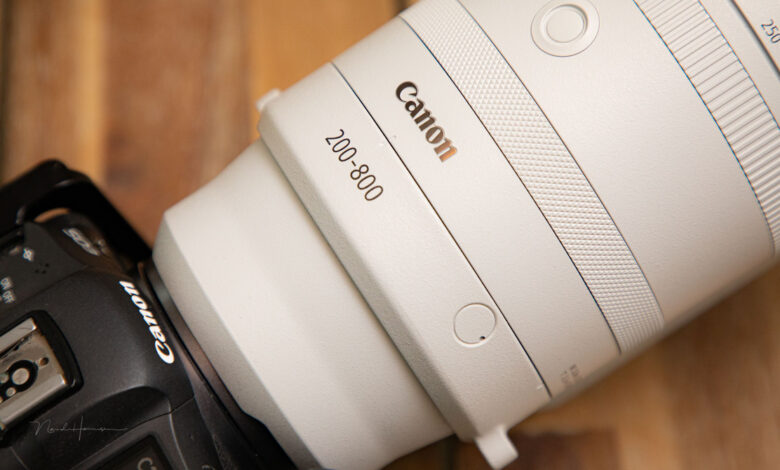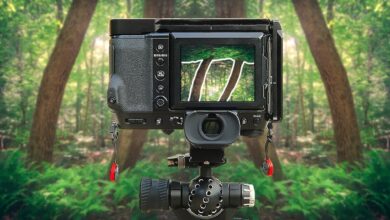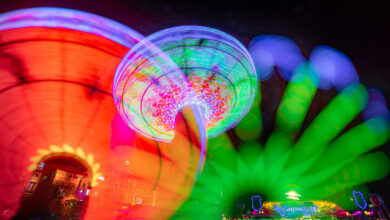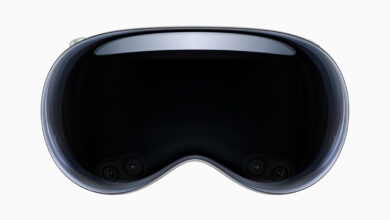Review of the Canon RF 200-800mm f/6.3-9 IS USM

If you’re looking for a long telephoto lens for the mirrorless R system, Canon has some great options available. The RF 200-800mm f/6.3-9 IS USM is the most recent one, and I predict it will become a very popular lens. And it’s with good reason.
If you ignore the extremely expensive long telephoto prime lenses in the Canon R-series, there are three lenses to choose from. One of those is the beautiful and versatile RF 100-500mm f/4.5-7.1L IS USM, a lens that covers a large focal length range, making it useful for both landscape photography and wildlife photography.
The other two lenses are the RF 600mm f/11 IS STM and the RF 800mm f/11 IS STM, both having a fixed focal length and a fixed f/11 aperture. These are extremely compact when collapsed. Although they perform reasonably well, there are some things that make these lenses less appealing.
The RF 200-800mm f/6.3-9 IS USM is a great addition to these lenses, providing a lot of focal length and addressing the downsides of the RF 600mm and RF 800mm primes. It’s also important to stress that it’s not an L-lens, therefore making it reasonably affordable.
Don’t be mistaken, the RF 200-800mm f/6.3-9 IS USM isn’t a small lens. It’s huge, measuring 31.4 centimeters in length and 41 centimeters when extended to 800mm. The diameter of the front lens element is 10.2 centimeters, giving it a filter size of 95mm.
Canon managed to keep the weight within reasonable limits. Weighing in at 2,050 grams, this lens can be used as a walk-around lens without problems if you carry the lens with the supplied strap, connected to the tripod collar.
The tripod collar is non-removable, but it rotates 360 degrees. Its size and spacing from the lens barrel are large enough to use it as a handle for carrying.
The lens has a zoom ring covered in rubber. It can’t be locked, but the lens features a ring for setting up the friction of the zoom ring. A secondary ring acts both as the programmable control ring and the focus ring.
The Switches
There are two switches available. The autofocus switch allows you to choose between manual and autofocus, but it is also used to set the desired function for the secondary ring. The second switch is for the lens stabilization. Two programmable buttons are also available.
The switches are not well defined. It’s a bit difficult to operate them, especially while wearing gloves. If you want to switch the secondary ring between manual focus and the control function, it can be very difficult to do so. The control setting is in the middle, and I found it a struggle to get the switch in that position.
Since the switch for the lens stabilization only has two settings, it’s much easier to operate. You will probably leave the lens on stabilizer mode for most of the time, making use of the 5.5 stops stabilization this lens offers. In theory, this allows you to shoot handheld up to 1/25 seconds. I found this to be difficult due to the lens’ size when zoomed to 800mm.
The stabilization has no special setting for panning. You have to rely on the system itself, which is able to detect the movement of the lens. It knows when you’re panning and will adjust the stabilization accordingly.
The Aperture
The aperture changes while zooming, as expected. It starts at f/6.3 at 200mm and ends with f/9 at 800mm focal length. As it turns out, the course of the apertures during zooming resembles that of the RF 100-500mm f/4.5-7.1L IS USM a lot. There is a difference of 1/3 to 2/3 stops at the largest.
At 640mm, you will reach the f/9 aperture, making the lens 2/3 stops more light-sensitive compared to both the RF 600mm f/11 IS STM and the RF 800mm f/11 IS STM. This isn’t a lot, but it can help reach a faster shutter speed without raising the ISO setting. However, in real-world use, this lens will still force you to use high ISO settings in less-than-ideal light situations.
Although a high ISO setting won’t be much of a problem with the ISO capabilities of Canon mirrorless cameras, you will be affected by image softness due to diffraction at f/9, especially with the higher resolution sensors.
The RF 200-800mm f/6.3-9 IS USM is compatible with the RF 1.4x and 2x extenders. The focal length becomes 280-1,120mm and 400-1,600mm respectively. However, the aperture will be affected as well, making it even more difficult in low-light situations. It will also affect the sharpness and increase diffraction.
Image Quality
I can only judge the image quality based on real-world examples. I haven’t done any indoor testing, nor have I looked at MTF charts. The results I found are great, making the lens extremely useful for wildlife and birds. The lens is sharp in the middle and a bit less in the corners. Since this lens is probably mostly used for photography with the subject in the center, this isn’t much of a problem. There is a bit of vignetting, but this is almost unnoticeable in real-world use.
Although I don’t have a direct comparison, I believe the results of the RF 200-800mm f/6.3-9 IS USM approach that of the RF 100-500mm f/4.5-7.1L IS USM. But it provides a noticeably better image quality compared to the RF 600mm f/11 IS STM and RF 800mm f/11 IS STM.
User Experience
The RF 200-800mm f/6.3-9 IS USM invites you to use it handheld. It’s not too heavy, and the image stabilization allows you to shoot at reasonable shutter speeds. Make sure you use the strap that is provided with the lens to relieve stress on the lens mount when carrying.
The focal length allows you to capture small birds at a reasonable distance. The ability to zoom back to 200mm makes it possible to maintain a good composition if the animal is closer than expected. The minimum focus distance is 80 centimeters at 200mm, but it’s 3.3 meters at 800mm. Both allow a 0.25x magnification.
There is a problem I encountered, though. Since the lens is easy to carry with you, it’s easy to forget how much 800mm focal length really is. Don’t underestimate the difficulty of photographing with such a focal length. It resulted in more images with motion blur than I usually encounter. You need to learn to operate such a lens when used handheld.
Conclusion
The first time I heard about this lens, I had my doubts. When I took it out of the bag, I was a bit shocked by the size. I couldn’t believe the RF 200-800mm f/6.3-9 IS USM would be comfortable to use. But these first impressions were misleading. When I took it out into the field, I discovered how great this lens really is.
Despite its size, it handles well. It’s not too heavy, and thanks to the image stabilization, it can be used handheld without a problem. But you have to get used to the focal length because it requires a bit more thought when holding it. Keep it as steady as possible.
However, there are also some downsides to this lens. It has no focus limiter, and the stabilization offers no special settings. The switches are not well defined, making them difficult to use. I don’t like the combined control/focus ring as well.
Although the image quality isn’t that of an L-series lens, it is close. If you are looking for an image with less distortion, less chromatic aberration, and better corner sharpness, you need the more expensive L lenses. Regarding a zoom lens, the only option is the RF 100-500mm f/4.5-7.1L IS USM or perhaps the amazing RF 100-300mm f/2.8L IS USM with an RF 2x Extender.
However, I believe the benefits of this lens exceed the downsides. That’s why I predict this to become a very popular lens for the photographer who needs such a long focal length. Still, if you are content with only 500mm, the RF 100-500mm f/4.5-7.1L IS USM will be a better choice. The RF 200-800mm f/6.3-9 IS USM is an excellent lens.
What I Like
- Image quality
- Zoom range up to 800mm
- Only weighs 2,050 grams
- Image stabilization up to 5.5 stops
- Can be used handheld
- Large tripod collar
- Strap connectors on the tripod collar
- Two programmable buttons
- Weather resistance
- Compatible with the RF 1.4x and 2x extenders
- Lens hood included
- Price
What I Didn’t Like
- Image is a bit soft at 800mm
- Switches are not well defined and difficult to use
- Diffraction limit is easily reached with the maximum aperture
- Combined focus/control ring
- No focus limiter
- Image stabilization has no extra settings
- Tripod collar doesn’t lock into place at 0, 90, and 180 degrees




